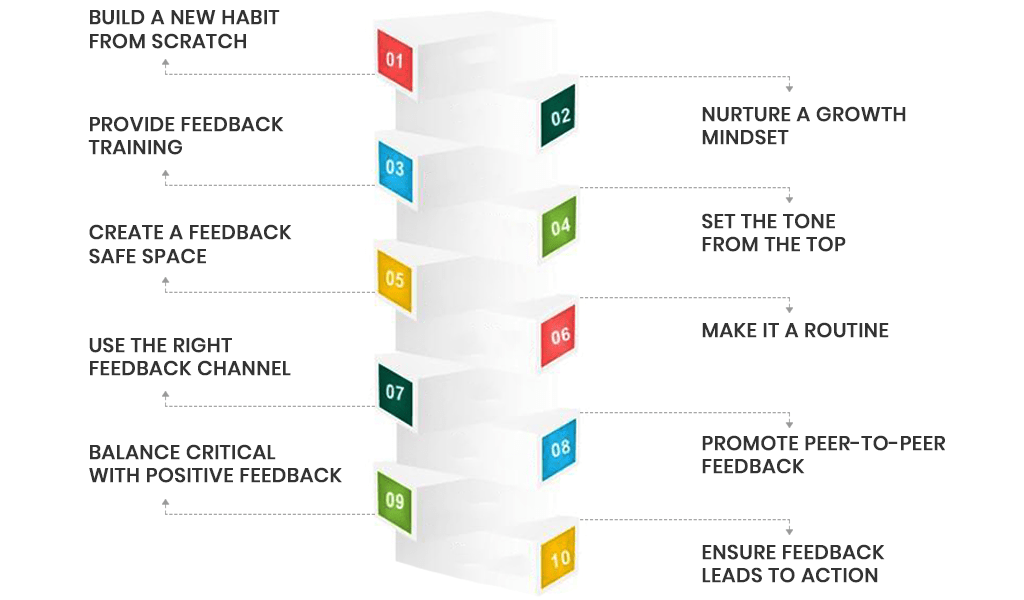Without feedback, organizations remain stagnant & employees hold themselves back.
Why is it so difficult to build relationships with employees when it comes to developing a great feedback culture? Is giving and receiving feedback a significant part of employee development

INTRODUCTION
Having an open and continuous feedback culture in your organization will help improve the growth and performance of employees as well as of an organization too. A healthy culture derives from healthy and honest feedback between members of an organization.
Building a culture where everyone is empowered for both giving and receiving feedback is a challenging one. However, organizations find themselves at a roadblock when it comes to implementing a feedback culture in the workplace.
Why isn’t there a one-size-fits-all approach to establishing a healthy culture, each organization must discover its way to do so?
If you invest in creating a culture of feedback, it is sure your company will reap benefits where your team will excel and grow together. You may be wondering now how exactly to get started. Here are some tips that you can use to build a strong & better feedback culture in your workplace.
KEY TAKEAWAYS
- Gather employee feedback to understand how you can improve morale.
- Feedback is information and insight flowing through you and your team.
- Consider giving employees professional development and learning opportunities to excel.
#1. BUILD A NEW HABIT FROM SCRATCH
During onboarding, you can teach your new hires the specific ways of working within your company and how much you value them to be open and honest.
#2. NURTURE A GROWTH MINDSET
Encourage a growth mindset by emphasizing employee training, continuous learning, and providing them with everything they need to expand their skill-sets and capabilities.
#3. PROVIDE FEEDBACK TRAINING
Provide training and resources to all of your team members as it is essential in establishing a strong feedback culture.
- Train how to communicate feedback effectively.
- Ask questions, seek examples, and clarify meaning.
- Explain how to give and receive feedback.
- Help them understand their resistance to feedback.
- Develop skills and help them to achieve goals.
#4. SET THE TONE FROM THE TOP
Building a culture of feedback starts with providing valuable feedback. Your leaders must hone their ability to give and receive feedback and consistently must ask for your employee’s feedback.
#5. CREATE A FEEDBACK SAFE SPACE
Facilitate an environment for your employees where they feel safe and comfy to provide feedback. Once trust is built and when they realize that they can speak freely for sure your feedback culture will quickly thrive.
#6. MAKE IT A ROUTINE
Ensure that your managers have regular feedback conversations and check-ins. A great example is to schedule a meeting at the end of the week where you can give some positive feedback to employees who did well in that week. It is a great way as it helps in boosting morale and team spirit within your team.
#7. USE THE RIGHT FEEDBACK CHANNEL
To make feedback a routine you should use the right feedback channels. People prefer to receive and provide feedback in many ways. When you provide different feedback channels, you give them opportunities in a way that they’re comfortable with.
Examples of different feedback channels and assess what works the best for you and your team:
- 1-on-1 sessions
- Team meetings
- Anonymous forms
- Online feedback platforms
- Employee surveys
#8. PROMOTE PEER-TO-PEER FEEDBACK
Where employees can give each other, feedback related to areas of improvement. It will help employees feel valued and are incredibly useful when it comes to giving feedback to underperforming employees.
#9. BALANCE CRITICAL WITH POSITIVE FEEDBACK
Your feedback must walk a fine line between honesty and negativity. Positive feedback is great for team morale, but you do need to give constructive critical feedback without it feeling like a personal attack that creates the right balance of praise and improvement.
#10. ENSURE FEEDBACK LEADS TO ACTION
In certain situations, the receiver might not fully understand and won’t ask for further clarification or doesn’t agree with the feedback but doesn’t want to risk getting into an argument. This can lead to resentment among team members and feedback also becomes useless. Instead, whenever feedback is given, the two parties should discuss and come to the right conclusion.
WRAPPING IT UP
With the right fit in the organization and with the right tool, they were able to succeed in strengthening the company’s brand, improving employee engagement & performance, and also increased business agility. Feedback culture when multiplied and accelerated by the information & insights, you and your team get benefitted.

